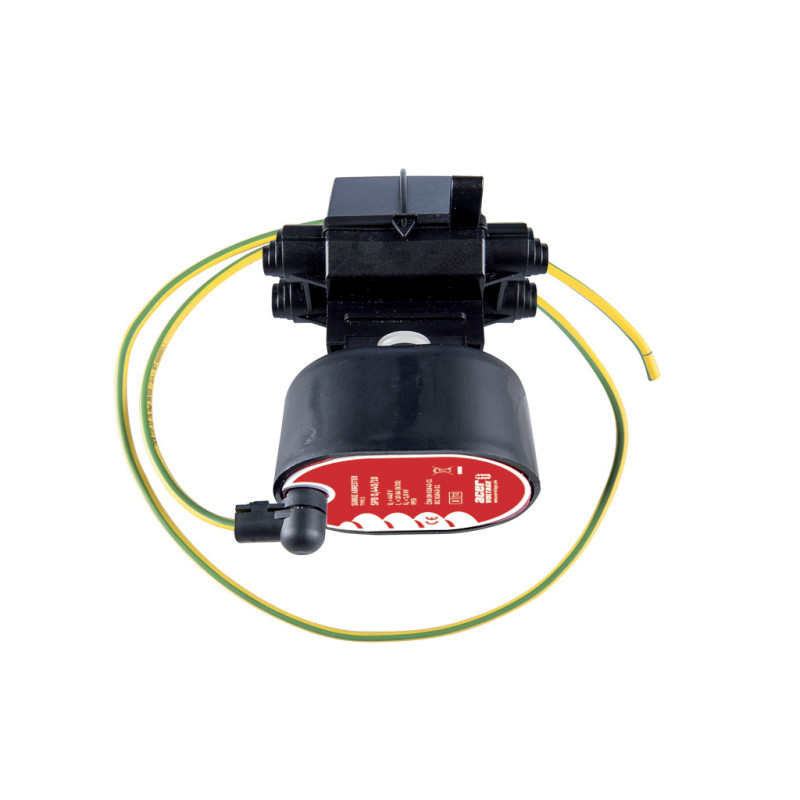SPB */10 S ** - surge arrester for insulated external lines in accordance with ČSN EN 61643-11 ed.2: 2013 with a rated discharge current of the arrester of 10 kA and the highest continuous operating voltage Uc = 280 V, 440 V, 500 V and 660 V. It provides protection against low-voltage overvoltages, in low-voltage overhead distribution networks it protects electrical devices, instruments, distribution transformer cabinets and reduces the risk of damage to home networks and devices connected to them due to atmospheric and switching overvoltages, in alternating current networks with a frequency of 48 to 62 Hz. SPB surge arresters protect against the destructive effects of electrical discharges and switching overvoltages. They are recommended for use in locations protected against direct contact, e.g., through localization or barrier protection. Destruction of the surge arrester due to a large surge is indicated by the opening of the red cover at the bottom of the housing. The SPB can be connected to all types of overhead lines and all types of conductors, including insulated conductors; for installation on the latter, it is supplied with an insulated terminal with a piercing needle. The connection with the insulated terminal allows for connecting a branch of the conductors to the protected object and for mounting and dismounting the surge arrester under voltage, without the risk of touching live parts. Version and Features
At continuous operating voltage, a current of hundreds of µA flows through the surge arrester, mostly capacitive in nature. The active component of the current is negligible. As the voltage at the surge arrester's terminals increases, the arrester smoothly transitions into a conductive state, limiting all types of surges. The response time is very short (typically 25 ns), so the surge arrester reliably limits even steep lightning surges. The surge arrester consists of a plastic housing with connecting leads, a waterproof and electrically insulated varistor encapsulated in silicone rubber, a thermal disconnect switch, and a signaling cover on the bottom of the housing. Another advantage is easy installation. The plastic housing is UV and weather-resistant and self-extinguishing – class V0. The connection screws and nuts are made of stainless steel. The surge arrester is equipped with a grounding cable with a terminal, available in green-yellow or black, and in lengths of 0.65 m, 0.8 m, or 1.0 m, according to the customer's specifications. Other lengths are also available upon request. The built-in disconnector is used to disconnect the arrester from the mains in the event of an overload, which can occur as a result of exceeding the varistor's limit parameters (absorption of greater energy, e.g., due to a prolonged increase in operating voltage above Uc, or due to high voltage induced by a lightning strike in the immediate vicinity). The maximum current of the varistor is 100 kA, 4/10 µs. With two consecutive 65 kA, 4/10 µs pulses, the varistor temperature can reach a value that disconnects the disconnector. Disconnection is signaled by opening the red cover on the bottom of the surge arrester's housing. During a varistor breakdown (e.g., when the maximum current is exceeded by a steeply rising pulse), the varistor itself can be ripped from the housing sleeve by the short-circuit current, without damaging or damaging the outer casing of the surge arrester. This ensures that the voltage-free surge arrester disconnects from the mains without damaging any surrounding components (except the lower part of the enclosure) or causing a flashover between busbars in the switchboard. The disconnection is again signaled by opening the cover on the lower part of the enclosure. When using an insulated terminal, all live components remain insulated and protected from direct contact.
Transport, Handling, and Storage Requirements
Individual surge arresters are packed in polyethylene bags and shipped in disposable cardboard boxes. Other packaging options are available upon request. Surge arresters are stored in cardboard boxes in covered warehouses at temperatures between -30°C and +30°C. Foam or water can be used as extinguishing agents. Handle them carefully during transport to avoid damaging the cardboard packaging.
Environmental Impact
There is no risk of negative environmental impact during transport, handling, storage, and use of the product. Damaged products should be taken to a landfill. Waste catalogue number: 07 02 99.








